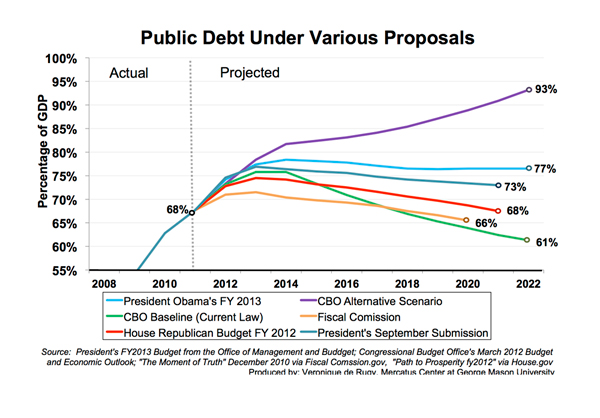- | Government Spending Government Spending
- | Data Visualizations Data Visualizations
- |
Public Debt Under Various Proposals
With the recent release of CBO’s budget outlook and the approaching release of the House Republican budget, it is important to put the budget numbers from a variety of proposals into proper perspective.
With the recent release of CBO’s budget outlook and the approaching release of the House Republican budget, it is important to put the budget numbers from a variety of proposals into proper perspective.
This week Mercatus Center research fellow Veronique de Rugy charts the debt held by the public as a percentage of the gross domestic product (GDP) under various budget proposals.
Projected debt is far larger—and growing at a faster rate—under the CBO's alternative budget scenario (purple line) than it does under any other proposal. By 2022 it reaches 94 percent of GDP, while other projections are estimated to be lower than 77 percent.
By contrast, the CBO’s baseline scenario (green line) paints a rosy picture that assumes the continuation of current law. House Republican Budget for FY 2012 and Fiscal Commissions (red and orange lines) projections are closer to the optimistic CBO baseline scenario rather than to the alternative scenario.
The alternative scenario is the most realistic depiction of the debt because this scenario does not assume that what happens in law is guaranteed to happen in the future, like the extension of expiring tax provisions or the effect of automatic spending reductions required by the Budget Control Act.
With the president’s current fiscal year 2013 budget released in February showing more debt than what he submitted only five months prior, the message is clear: We are moving toward more debt. A policy of over-optimism will only drive us deeper into the debt hole.
Veronique de Rugy discusses excessive optimism in official budget forecasts in a Mercatus chart.
Note on data
Proposals have different start and end dates for their 10-year growth periods since some were released in 2011 or 2012. Budget proposals from the Fiscal Commission, House Republican, and President’s September submission were released in 2011.


